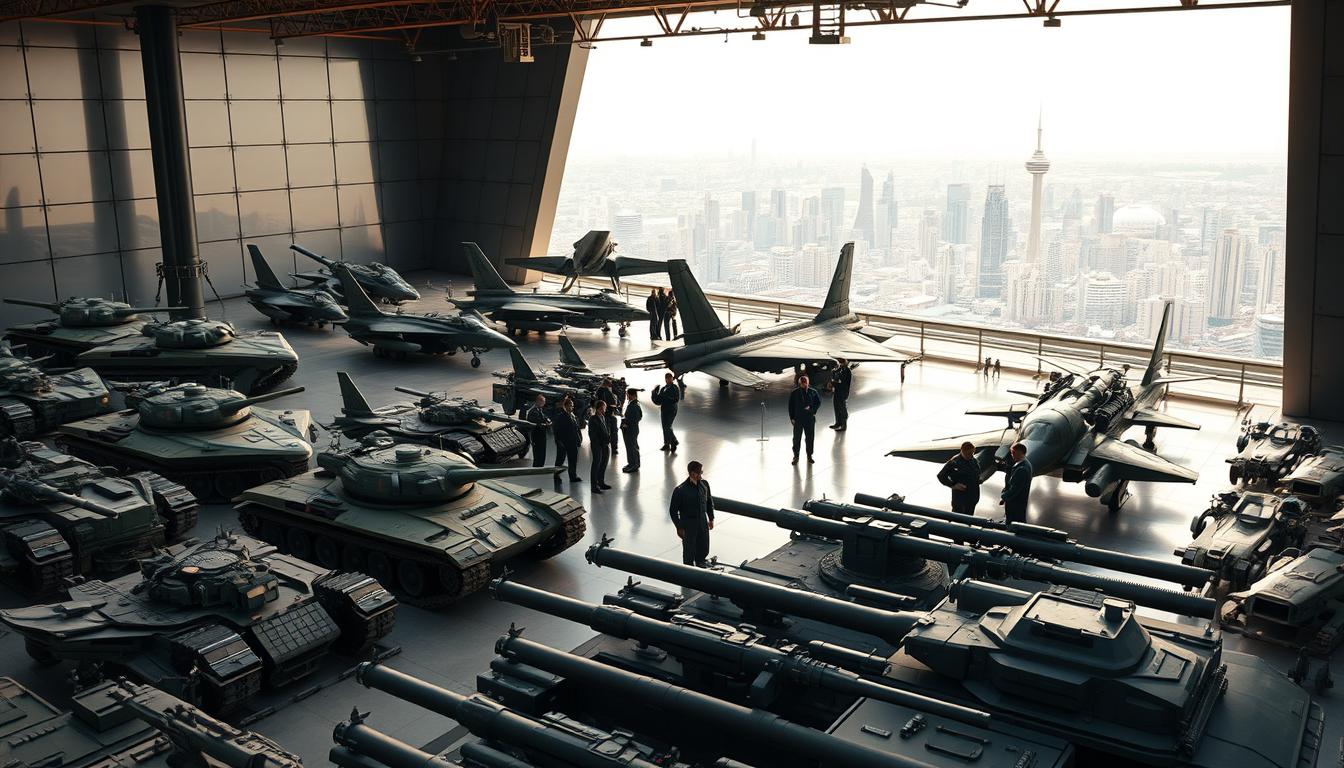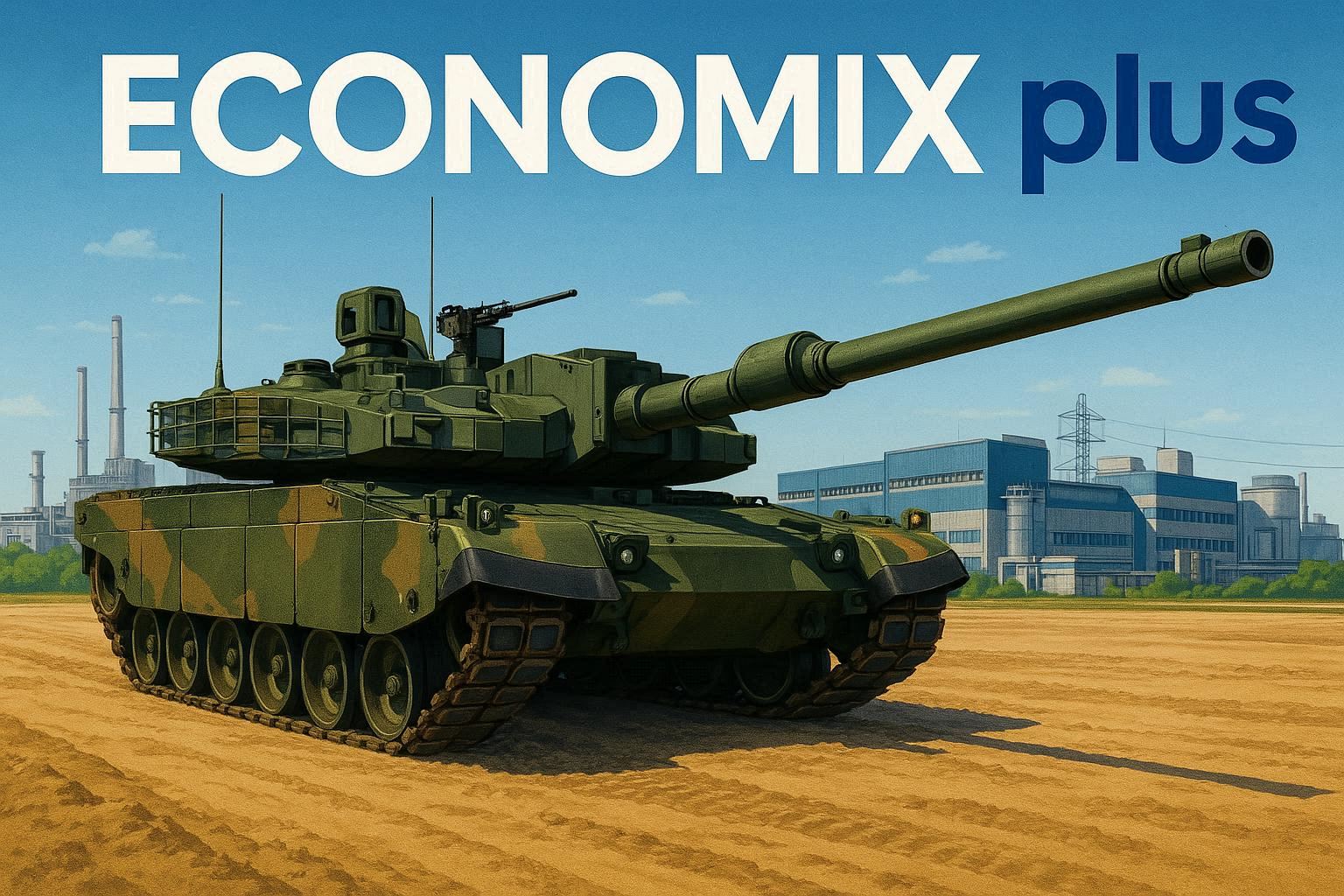Have you ever wondered how geopolitical conflicts reshape the world’s arms industry? Recent data from SIPRI reveals unprecedented shifts in the global arms trade, driven by rising tensions and technological advancements. Between 2020 and 2024, Ukraine’s arms imports surged by 100 times, highlighting how conflict fuels demand.
The United States remains a dominant player, accounting for 43% of global exports. Meanwhile, Russia’s share plummeted by 64%, signaling a dramatic decline. This shift underscores the evolving dynamics of the arms industry, where geopolitical power plays a pivotal role.
In 2023, the top 100 arms companies generated $632 billion in revenue, showcasing the massive scale of this sector. Emerging trends, such as increased domestic production in Asia and demand for advanced weapon systems, are reshaping the landscape. Corruption risks and technological innovation further complicate the market’s future.
This article dives into the forces driving these changes, offering data-driven insights into the arms industry’s current state and future trajectory.
Key Takeaways
- Ukraine’s arms imports increased 100 times from 2020 to 2024.
- The U.S. holds 43% of the global arms export market.
- Russia’s arms exports declined by 64% in the same period.
- Top 100 arms companies earned $632 billion in 2023.
- Asia is seeing a rise in domestic arms production.
- Advanced weapon systems are in high demand globally.
- Corruption remains a significant risk in the arms trade.
Overview of the Global Arms Market
The dynamics of international arms transfers have evolved significantly over the years. From regional dominance to technological advancements, the industry reflects broader geopolitical shifts. Understanding these trends provides valuable insights into the forces shaping the market.
Historical Trends in Arms Transfers
Over the past 25 years, Asia and Oceania have dominated as the top importing regions, accounting for 33% of arms transfers between 2020 and 2024. This historic trend contrasts with recent declines in the Middle East (-20%) and Asia (-21%). Meanwhile, Europe saw a 155% surge in imports, driven by heightened tensions.
The United States has shifted its focus from the Middle East, where it previously directed 33% of its exports, to Europe, which now receives 35%. This transition underscores the changing priorities in international arms trade. Supply chain challenges have also impacted major producers like Lockheed Martin and Raytheon, while smaller companies adapted more swiftly.
“Global arms transfer volume remained stable from 2015 to 2019 but increased by 18% compared to 2005-2009.”
Key Drivers of the Arms Industry
Geopolitical conflicts remain a primary driver of arms transfers. The Russia-Ukraine war led to a 105% increase in NATO imports, while the Gaza conflict boosted Israeli revenues by 18%. Technological advancements also play a critical role, with 45% of U.S. missile exports directed to seven states and 13 pending deliveries.
Combat aircraft accounted for 45% of U.S. long-range strike exports between 2020 and 2024. This highlights the growing demand for advanced weapon systems. Despite these shifts, global arms transfers have remained relatively flat, revealing a paradox in the industry.
| Region | Import Change (2020-2024) |
|---|---|
| Europe | +155% |
| Asia | -21% |
| Middle East | -20% |
These trends illustrate the complex interplay of historical patterns and current drivers in the arms industry. As the market evolves, understanding these dynamics becomes increasingly crucial.
Major Players in the Arms Industry
Powerful countries dominate the landscape of international arms transfers. A few nations hold significant influence, shaping the market’s direction and trends. This section explores the key players and their roles in the industry.
The United States: Dominance in Arms Exports
The United States remains the largest arms exporter globally, accounting for 43% of the market. It supplied weapons to 107 countries, with Saudi Arabia receiving 12% of its exports. A strategic shift has seen 64% of U.S. exports directed to NATO Europe, moving away from its historical focus on the Middle East.
Lockheed Martin, the leading arms company, generated $65.7 billion in revenue in 2023. This highlights the U.S.’s stronghold on the industry. Advanced weapon systems, such as combat aircraft, make up a significant portion of its exports.
Russia: Decline in Global Arms Exports
Russia’s share of the arms market has plummeted by 64% in recent years. Its exports now reach only 33 countries, with 66% going to India, China, and Kazakhstan. Even before the Ukraine conflict, exports between 2020 and 2021 were at 20-year lows.
This decline reflects geopolitical tensions and economic challenges. Russia’s inability to adapt to changing market dynamics has further weakened its position.
France and Other European Exporters
France has emerged as the second-largest exporter, holding a 9.6% share of the market. Its exports to European buyers surged by 187%, driven by combat aircraft sales to Greece and Croatia. India also accounts for 28% of France’s arms exports.
Other European companies, like Rheinmetall, have seen growth due to increased demand from Ukraine. In contrast, BAE Systems has faced challenges, including corruption scandals.
| Country | Export Share | Key Markets |
|---|---|---|
| United States | 43% | NATO Europe, Saudi Arabia |
| France | 9.6% | Europe, India |
| Russia | 8.5% | India, China, Kazakhstan |
Emerging players like Türkiye are also making waves. Baykar’s UAVs, with a 90% export ratio, are disrupting traditional markets. These shifts highlight the evolving nature of the arms industry.
Regional Dynamics in Arms Imports
Regional shifts in arms imports reveal how conflicts reshape global security. From Europe to Asia, the flow of military equipment reflects both local needs and external pressures. Understanding these patterns provides insights into the broader impact of geopolitical tensions.

Europe: Increased Arms Imports Due to Conflict
Europe has seen a dramatic rise in arms imports, driven by heightened security concerns. NATO countries, in particular, experienced a 105% increase, with over 500 U.S. combat aircraft on order. Ukraine alone accounted for 8.8% of global imports, receiving 45% of its supplies from the United States.
Germany and Poland also played significant roles, contributing 12% and 11% respectively. This surge highlights how regional conflicts can rapidly alter import patterns. The demand for advanced weapon systems continues to grow as countries prioritize defense.
Asia and Oceania: Shifting Import Patterns
Asia and Oceania remain key players in the arms market, holding a 33% global share. However, China’s imports dropped by 64%, marking the first time it fell out of the top 10 since the early 1990s. This decline reflects a shift toward domestic production and self-reliance.
Japan stands out as an outlier, with a 93% increase in imports. Meanwhile, India and Pakistan show contrasting trends. India’s imports fell by 9.3%, while Pakistan’s rose by 61%, underscoring the rivalry between the two nations.
Middle East: Declining Imports Amid Regional Tensions
The Middle East has seen a 20% decline in arms imports, despite ongoing conflicts. Saudi Arabia’s imports fell by 41%, while Qatar emerged as the third-largest global importer. The United States remains a dominant supplier, accounting for 52% of the region’s imports.
Israel’s imports remained stable, with 66% coming from the U.S. This stability contrasts with the broader regional decline, highlighting the complex dynamics of the Middle East.
| Region | Key Trends |
|---|---|
| Europe | 105% import surge, Ukraine leads with 8.8% of global imports |
| Asia | 33% global share, China’s imports drop 64% |
| Middle East | 20% decline, Qatar becomes third-largest importer |
These regional dynamics illustrate how security needs and external pressures shape the arms trade. From Europe’s surge to Asia’s paradox, each region tells a unique story of conflict and adaptation.
Impact of Conflict on Arms Trade
Conflicts around the world have a direct and measurable impact on the flow of military equipment. From Ukraine to the Middle East, regional tensions drive demand for weapons and reshape supply chains. This section explores how specific conflicts influence arms transfers and the broader implications for the industry.

Ukraine: A Case Study in Arms Imports
Ukraine’s arms imports surged dramatically, accounting for 8.8% of global imports in recent years. Over 35 nations supplied military equipment, highlighting the international response to the conflict. The United States alone provided 45% of Ukraine’s supplies, including advanced weapon systems like missiles and combat aircraft.
Corruption risks emerged as a significant challenge. A $42 million illicit deal was thwarted through a Kenyan shell company, exposing vulnerabilities in the supply chain. Despite these risks, Ukraine’s ad-hoc supply network demonstrates how conflict zones can rapidly mobilize international support.
Gaza and the Middle East: Arms Trade in Conflict Zones
The Middle East saw contrasting trends in arms transfers. While overall imports declined by 20%, Israel’s revenues hit a record $13.6 billion in 2023. Türkiye’s arms exports also grew by 24%, driven by demand for UAVs and other advanced systems.
Hamas and Hezbollah rely heavily on Iranian weapons, while Israel’s arsenal is dominated by U.S.-made systems. This dynamic underscores the regional arms race and the role of external suppliers in fueling conflicts.
| Region | Key Trends |
|---|---|
| Ukraine | 8.8% global imports, 35+ suppliers, $42M illicit deal thwarted |
| Middle East | 20% import decline, Israel’s $13.6B revenue, Türkiye up 24% |
North Korea’s involvement in the arms trade added another layer of complexity. Artillery and missiles were exported to Russia, violating UN sanctions. This highlights the growing role of illicit transfers in conflict zones.
Rheinmetall’s scaling of 155mm shell production further illustrates the economic impact of ammunition demand. Meanwhile, Baykar’s $1.9 billion revenue from UAVs reflects the shifting priorities in modern warfare.
Emerging Trends in the Arms Market
The arms industry is undergoing transformative changes, driven by innovation and shifting geopolitical priorities. Two key trends are reshaping the landscape: the rise of domestic production and the growing demand for advanced weapon systems. These developments reflect how nations are adapting to new security challenges and technological advancements.

Rise of Domestic Arms Production
Countries are increasingly focusing on self-reliance in defense. China, for example, has replaced 64% of its previous Russian imports with domestic production. This shift highlights its growing military-industrial capabilities, which now account for 5.9% of global exports despite political barriers.
India is another notable example. Over the past decade, its reliance on Russian imports fell from 72% to 36%. This diversification reflects a strategic push to strengthen local defense companies and reduce dependency on foreign suppliers.
Japan is also embracing domestic production, with a 300% increase in orders for locally developed systems. This trend aligns with its broader efforts toward military normalization and enhanced security.
Shift Towards Advanced Weapon Systems
Technological advancements are driving demand for sophisticated weapon systems. The U.S. has delivered long-range missiles to seven states, with 13 additional deals pending. These systems are critical for modern warfare, offering precision and strategic advantages.
Artificial intelligence is playing a pivotal role in the development of unmanned aerial vehicles (UAVs). Companies like Baykar are leading the charge, with UAVs accounting for 90% of their exports. Hypersonic missile development is another area of focus, reflecting the race for next-generation capabilities.
Materials science is also advancing, with rare earth metals being integrated into components for systems like the F-35. These innovations are setting the stage for future trends, including the potential introduction of space-based weapons into the trade calculations.
“The arms industry is no longer just about quantity; it’s about quality and innovation.”
NATO’s “ring-exchange” programs are accelerating modernization in Eastern Europe, while South Korea’s defense exports grew by 39% through European contracts. These developments underscore the dynamic nature of the market and its ability to adapt to emerging challenges.
Challenges and Corruption in the Arms Trade
The arms trade faces significant challenges, including corruption and illicit transfers, which undermine global security. These issues not only distort market dynamics but also pose risks to international stability. Understanding these problems is crucial for addressing their impact on the industry.
Corruption in Arms Procurement
Corruption remains a persistent issue in arms procurement. High-profile scandals, such as BAE Systems’ $7.4 billion Saudi bribes through offshore shells, highlight the extent of the problem. The Al Yamamah scandal, involving $1 billion funneled to Prince Bandar via Riggs Bank, further exposes the vulnerabilities in the system.
In the MENA region, 52% of U.S. exports go to states classified as “high corruption.” This raises concerns about the ethical implications of such transactions. Financial secrecy tools, like free trade zones (FTZs), have enabled deals such as the $42 million Kenyan shell case, complicating efforts to combat corruption.
Illicit Arms Transfers and Their Consequences
Illicit arms transfers pose a significant threat to global security. Over 500,000 small arms are missing from Libyan stockpiles, fueling conflicts across regions. These transfers often bypass legal frameworks, as seen in the Dolarian case, which violated the Foreign Corrupt Practices Act (FCPA).
Efforts to curb these activities include proposals for beneficial ownership registries and enhanced monitoring of FTZs. Such measures aim to increase transparency and accountability in the arms trade.
| Issue | Impact |
|---|---|
| Corruption in procurement | Distorts market dynamics, undermines trust |
| Illicit arms transfers | Fuels conflicts, bypasses legal frameworks |
| Financial secrecy tools | Enables illegal deals, complicates oversight |
Addressing these challenges requires coordinated efforts from governments, industry actors, and international organizations. Only through transparency and accountability can the arms trade become more secure and ethical.
Conclusion
The arms trade reflects the complexities of modern geopolitics. While the U.S. remains dominant, multipolar production growth, especially in Asia, is reshaping the industry. Countries like China and India are prioritizing domestic manufacturing, challenging traditional exporters.
Corruption remains a significant risk, with the $204 billion sector vulnerable to financial secrecy. SIPRI’s 2023 report highlights rising revenues, signaling prolonged demand for advanced systems. This growth underscores the need for transparency and accountability.
Policy implications are profound. NATO standardization contrasts with national production goals, creating a delicate balance. As the world navigates these challenges, the arms trade continues to mirror geopolitical tensions with deadly precision.
FAQ
▶
▶
▶
▶
▶
▶
▶
▶














